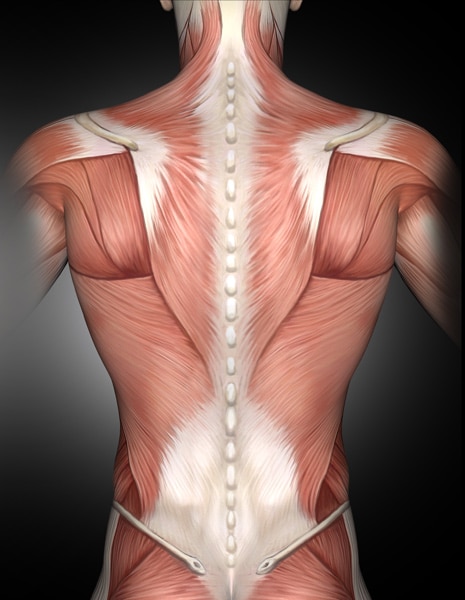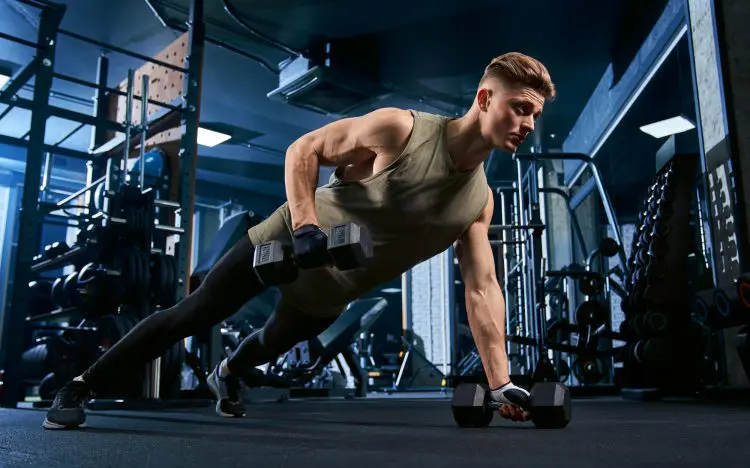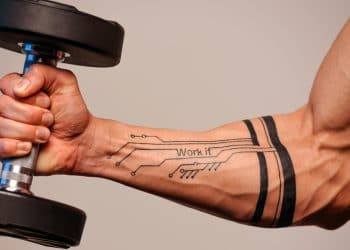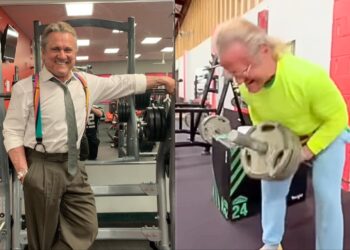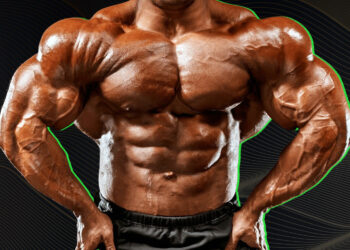There are lots of exercises named after animals – spider curls, donkey calf raises, downward dogs, inchworms, bear crawls, crab walks, and the cobra pose, to mention a few.
Now you can add another animal-inspired exercise to the list – gorilla rows.
The name isn’t just a whimsical choice; perform this exercise and you’ll channel the presence of a silverback gorilla on the prowl. And while the comparison might seem humorous, remember that silverbacks are epitomes of strength and muscular prowess. So, if you’ve been repeating the same roster of back exercises and crave a fresh challenge, the gorilla row promises to level up your routine
What are Gorilla Rows?
Gorilla row exercise is an innovative take on the traditional row. It targets the mid and upper back, lats, and shoulders, while your core is put to the test to maintain stability and posture. The foundation of the movement is the hip-hinge position, reminiscent of a deadlift’s starting stance.
However, it comes with a unique challenge: as one arm rows, the other serves as an anchor, ensuring you remain balanced. This not only demands strength but introduces a subtle rotation to the torso, bolstering flexibility.
While kettlebells are a popular choice, you can also opt for dumbbells. Just ensure they’re elevated to about mid-shin level before commencing.
Gorilla Row Muscles Worked
Gorilla rows are a compound horizontal pulling exercise. As such, they involve several joints and muscles working together.
The main muscles affected by gorilla rows are:
Latissimus dorsi – known as your lats for short, these muscles are located on the side of your upper back. The lats give your back its width. The functions of the lats are shoulder adduction and extension. Gorilla rows are a very effective lat builder.
Trapezius – located across your upper back, the trapezius or traps for short give your back much of its thickness. Known as the traps for short, there are three sets of trapezius fibers; upper, middle, and lower. The upper traps are responsible for shoulder girdle elevation, while the lower traps depress your shoulder girdle. The mid-traps pull your shoulder blades back and together, which is a movement called retraction. Gorilla rows involve all three but mostly work the mid-traps.
Rhomboids – the rhomboids work with your middle traps to pull your shoulders back and together. They’re located beneath your mid traps and between your shoulder blades.
Deltoids – there are three sets of fibers or heads that make up the deltoids; anterior, medial, and posterior. All three are involved in gorilla rows. However, the posterior or rear deltoids are most active as they work with your lats to extend your shoulders.
Biceps brachii – while gorilla rows are definitely a back exercise, you can’t do them without also using your biceps. Located on the front of your upper arm, the biceps flex your elbows.
Forearms – gorilla rows are an excellent forearm exercise and require and develop a strong grip. Kettlebells tend to have thicker handles than dumbbells, making them more challenging to hold, increasing forearm engagement.
Erector spinae – leaning forward and maintaining that position involves your erector spinae, which is the collective name for the three muscles that run up either side of your spine. While some of your weight is supported during gorilla rows, your erector spinae are still strongly engaged.
Core – core is the collective name for the muscles of your midsection, namely your rectus abdominis, obliques, and transverse abdominis. These muscles contract statically to create intra-abdominal pressure and help support your spine during gorilla rows.
Lower body – gorilla rows are an upper-body exercise. Still, your legs are also involved because they’re done while standing in a bent-over position. However, gorilla rows probably won’t do much for lower body strength or size.
How to Do Gorilla Rows
Get more from gorilla rows while keeping your risk of injury to a minimum by following these guidelines:
- Place two kettlebells on the floor about hip-width apart. The handles should be parallel. Stand just behind your kettlebells, feet a little wider than your weights.
- Bend your knees slightly, hinge forward from your hips, and reach down and grasp the handles. Push your knees out to make space for the weights.
- Brace your core and make sure your lower back is slightly arched and not rounded.
- Keeping a tight grip on one kettlebell, row the other weight up and back toward your hip. Lead with your elbow and keep your wrist straight.
- Lower the kettlebell back to the floor and then repeat on the opposite side.
- Continue alternating arms for the duration of your set.
Gorilla Row Benefits and Drawbacks
Not sure if gorilla rows are worth adding to your workouts? Consider these benefits and then decide!
An unusual exercise – doing something new could be just what’s needed to reignite your back-building progress. If you’re bored of the same old rowing variations, this exercise will make an excellent addition to your upper body workouts.
Lower back-friendly – while doing gorilla rows does involve leaning forward, at least some of your weight is supported by one arm. As such, gorilla rows are more lower back-friendly than unsupported bent-over rows, T-bar rows, and Pendlay rows.
Very functional – gorilla rows involve working your upper back, lower back, arms, core, and legs simultaneously. Invariably, that’s how these muscles usually work in nature, i.e., when picking up something heavy.
A unilateral exercise – unilateral or single-limb exercises are good for identifying and fixing left to right strength imbalances. While minor strength discrepancies are to be expected, too big a difference between left and right could lead to postural issues and injuries.
Level Up Your Fitness: Join our 💪 strong community in Fitness Volt Newsletter. Get daily inspiration, expert-backed workouts, nutrition tips, the latest in strength sports, and the support you need to reach your goals. Subscribe for free!
Master your hip hinge – the hip hinge is a critical movement for anyone who does deadlifts, bent-over rows, Romanian deadlifts, kettlebell swings, and even squats. Gorilla rows teach you to hold a static hip hinge, reinforcing this all-important skill.
While gorilla rows are a mostly beneficial back and biceps exercise, there are also a couple drawbacks to consider:
Equipment – you need two kettlebells of the same weight to do gorilla rows. That’s no problem if you work out in a well-equipped gym, but it could be an issue if you train at home and only have one kettlebell. However, there are single-arm and dumbbell variations you can do instead.
Risk of lower back injury – lifters with tight hamstrings or a weak core may find that they round their backs during gorilla rows. This can lead to lower back pain and injury. Take the pressure off your lower back by placing your kettlebells on a raised platform, such as a low step. This means you won’t have to lean over as far and are less likely to round your lumbar spine.
7 Gorilla Row Variations and Alternatives
Gorilla rows are a highly effective back exercise, but that doesn’t mean you need to do them all the time. There are several variations and alternatives you can use to keep your workouts productive and interesting:
1. Dumbbell Gorilla Row
No kettlebells? No problem! You can also do gorilla rows using dumbbells. However, because the handles are much lower to the ground, you may need to put your weights on a raised platform to avoid rounding your lower back.
How to do it:
- Place two dumbbells on the floor, roughly shoulder-width apart. Stand between them with your knees slightly bent.
- Lean forward from your hips and reach down to grab the dumbbells. Keep your back flat and your torso level with the floor. Brace your abs.
- Bend one arm and pull the dumbbell up and into your side. Keep your upper arm close to your body.
- Lower the weight back to the floor and then repeat on the opposite side. Continue alternating arms for the duration of your set.
2. Single-Arm Gorilla Row
Only got one kettlebell? That’s okay; you can also do gorilla rows using one arm at a time. In addition to working your upper back, lower back, and biceps, this variation also works your oblique or waist muscles.
How to do it:
- Place your kettlebell on the floor so that handle is in a neutral position. Stand just behind the kettlebell, feet a little wider than your weights.
- Bend your knees slightly, hinge forward from your hips, and reach down and grasp the handle.
- Brace your core and make sure your lower back is slightly arched and not rounded.
- Row the weight up and back toward your hip. Lead with your elbow and keep your wrist straight. Make sure your hips and shoulders remain level and do not twist.
- Lower the kettlebell back to the floor and repeat.
- On completing your set, swap arms and do the same number of reps on the opposite side.
3. Pendlay Rows
Named after USA weightlifting and powerlifting coach Glen Pendlay, the Pendlay row is basically a barbell version of gorilla rows. However, because you’ll be using a barbell and won’t be able to use one arm to support your upper body, this exercise involves more lower back, core, and leg engagement.
How to do it:
- Start with your barbell on the floor. Stand with your feet about hip to shoulder-width apart, toes under the bar.
- With your knees slightly bent, hinge forward from the hips and bend over until your upper body is parallel to the floor. Make sure your lower back is slightly arched and not rounded.
- Grab the barbell with an overhand, slightly wider than shoulder-width grip. Tuck your chin in and lengthen your neck; do not lift your head and look forward.
- Brace your core, squeeze your shoulder blades together, and pull the bar up into your abdomen. The bar should touch your stomach. Lead with your elbows, keeping your upper arms tucked in close to your sides. Your upper body should remain stationary throughout. Do not use your legs or lower back to lift the weight. If you can’t keep your upper body still, you are probably using too much weight.
- Under control, lower the barbell back down the floor and allow it to touch down. Reset your core and repeat.
Read more about Pendlay rows here.
4. Plank Row
Like Gorilla rows, plank rows work your upper back and biceps. However, because you’re in a plank position, they’re considerably more core-centric. Don’t go too heavy too soon. This is a very challenging exercise.
How to do it:
- Holding a dumbbell or kettlebell in one hand, place your other hand on a bench. Keeping your supporting arm straight, walk your feet back and into a plank.
- Brace your core and pull your shoulders down and back. Let the weight hang down from your shoulder.
- Bend your arm and, leading with your elbow and keeping your wrist straight, row the weight up and into your lower ribs.
- Extend your arm and repeat.
- After completing your set, rest a moment, swap sides, and then do the same number of reps with the opposite arm.
5. Wrestler’s Row
Gorilla rows use an alternating arm action with each rep starting with the weight on the floor. The wrestler’s row is similar, but every rep begins with the weight already pulled up and into your lower ribs.
How to do it:
- Holding a dumbbell or kettlebell in each hand, stand with your feet about shoulder-width apart, knees slightly bent. Brace your abs and pull your shoulders down and back.
- Without rounding your lower back, lean forward until your upper body is almost parallel to the floor. Bend both arms and pull the weights into your lower ribs. This is your starting position.
- Keeping one arm stationary, lower the other weight down to arms’ length and then row it back in.
- Extend the other arm and pull it back in.
- Continue alternating arms for the duration of your set.
6. Renegade Rows
Renegade rows are a lot like gorilla rows, but you do them from a full plank position. This increases core engagement. Turn this back exercise into a total upper body move by doing a push-up between rows.
Learn how to do renegade rows here.
7. Towel Grip Inverted Row
As well as being a great back and biceps builder, gorilla rows provide your forearms with an effective workout. Towel grip inverted rows work the same muscles, but all you need to do them is a couple of old gym towels and a waist-high bar. They’re also easier on your lower back than gorilla rows.
How to do it:
- Set the bar on a squat rack or Smith machine to about waist height. Drape two towels over the bar about shoulder-width apart.
- Sit on the floor below the bar and grab the towels. Squeeze the ends together as hard as you can.
- With your arms straight, extend your legs and lift your hips.
- Bend your arms and pull your chest up to your hands.
- Extend your arms and repeat.
Learn more about inverted rows here.
Gorilla Rows – Wrapping Up
If you want your back to grow, you’ve got to row, or so say most bodybuilders. While pull-ups, chin-ups, and pulldowns are good for building a wider back, rows are a must if you want upper back thickness.
There are lots of rows to choose from, and yet most exercisers settle for the same old single-arm, cable, and bent-over variations. Not that there is anything wrong with these exercises, but if that’s all you ever do, your back-building progress will soon grind to a halt.
Add some variety to your workouts with gorilla rows. They’re uniquely challenging, and that’s exactly what you need to get out of a training rut.
Build a bigger, more muscular back and pump up your biceps with gorilla rows! Beating your chest between sets is purely optional…
Interested in measuring your progress? Check out our strength standards for Pendlay Row, Pull Ups, T Bar Row, and more.


